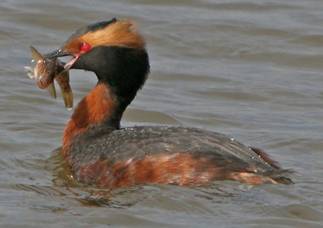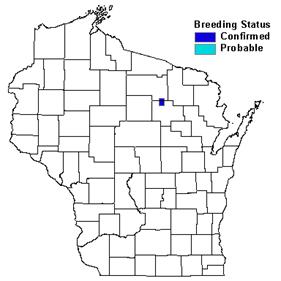Photo by Scott Franke 

Status/Protection
- Global Rank: G5 Key to global and state ranks
- State Rank: S4N
- WBCI Priority: SGCN, State Special Concern
Population Information
The Federal BBS information can be obtained at http://www.mbr-pwrc.usgs.gov/bbs/bbs.html by clicking on Trend Estimates and selecting the species in question. All estimates are for time period (1966-2005). This species is not well monitored using BBS methodology or other conventional survey techniques.
- Federal Breeding Bird Survey: significant decline
- Federal Breeding Bird Survey (WI): N/A
- Federal Breeding Bird Survey (BCR 23): N/A
- Federal Breeding Bird Survey (BCR 12): N/A
- WSO Checklist Project: significant inverted u-shaped trend (1983-2007)
Life History
- Breeding Range: Alaska east to the Prairie Provinces of Canada; also scattered location in the northern U.S.
- Breeding Habitat: Shallow freshwater ponds and marshes containing beds of emergent vegetation (Stedman 2000).
- Nest: Floating platform often anchored to emergent plants (Ehrlich et al. 1988).
- Nesting Dates: Eggs: June in Wisconsin but few records; mid-May to early June elsewhere in range (Stedman 2000).
- Foraging: Surface dives (Ehrlich et al. 1988).
- Migrant Status: Short-distance migrant.
- Habitat use during Migration: Inland Open Water, Great Lakes Open Water as well as ocean coasts and other large bodies of water (Stedman 2000).
- Arrival Dates: Mid-March to mid-May (Robbins 1991).
- Departure Dates: Early September to early December (Robbins 1991).
- Winter Range: From Alaska south to northern Baja along the Pacific Coast, along the Atlantic Coast south through Florida, and along the Gulf coast to southern Texas (Stedman 2000).
- Winter Habitat: Both fresh and salt water habitats, mostly larger lakes or nearshore areas along ocean coastlines (Stedman 2000).
Habitat Selection
Within its core nesting areas from Alaska and southern Canada, Horned Grebe nest sites are typically located in shallow freshwater ponds containing a mixture of open water and emergent vegetation (Stedman 2000). Cattails, sedges, willows, and other emergent vegetation provide nest materials and cover. Pond size often influences Horned Grebe nest site selection, with the most heavily used ponds occurring between 0.3-2 ha in northwestern Canada (Fournier and Hines 1999) and 0.1-8.4 ha in Manitoba (Ferguson and Sealy 1983 cited in Stedman 2000). In Wisconsin, this species has been recorded breeding on few occasions (Brooks 2006) and is better known as a fairly common to common migrant on larger inland lakes and both Lakes Superior and Michigan. Robbins (1991) once recorded 96 on Lake Menomin in Menomonie, while flocks of up to 500 birds have been seen on Lake Michigan during spring migration. At Lake Superior’s Chequamegon Bay near Ashland, hundreds are observed almost daily during fall migration and nearly 1,500 were recorded during a spring fallout on 22 April 2006 (R. Brady, pers. comm.).
Habitat Availability
Wisconsin is on the extreme southeastern edge of the Horned Grebe breeding range. Historically, breeding was documented in Oconto, Brown, Racine, Burnett, and Jefferson counties and more recently in Langlade County (Robbins 1991, Brooks 2006). Although habitat availability does not seem to be limiting Horned Grebes in Wisconsin, several factors can degrade seemingly suitable habitat. Many inland lakes have suffered from fluctuating water levels, increased sedimentation, and eutrophication, resulting in a decline of food resources for Horned Grebes (WDNR 2003). Exotic plant and animal species and shoreline development have degraded aquatic habitats of the Great Lakes and inland lakes and may lessen their suitability to this species (WDNR 2005).
Population Concerns
Few population data exist for this species. The Horned Grebe is detected on very few routes of the Breeding Bird Survey but these data seems to indicate population declines range-wide (Sauer et al. 2005). In Wisconsin, this species is an extremely rare breeder and is not adequately sampled on BBS routes. Targeted survey efforts at migratory stopover sites would be more effective for assessing this species’ current status in Wisconsin. Mortalities associated with fishing nets and oil spills are serious concerns throughout its winter range. In agricultural areas, chemical and agricultural runoff may degrade habitat and impact prey populations (Stedman 2000).
Recommended Management
Partnerships between state and federal agencies and private organizations dedicated to the restoration, conservation, and management of Great Lakes ecosystems will benefit Horned Grebes. Improved regulations and education are needed to prevent the introduction of additional exotic species and slow the spread of existing aquatic invasive species. Regulations that eliminate or limit the presence of organochlorine contaminants also are recommended (WDNR 2005). Conservation and management strategies for this species should be focused in the following ecological landscapes: Central Lake Michigan Coastal, Northern Lake Michigan Coastal, Southern Lake Michigan Coastal, and Superior Coastal Plain (WDNR 2005).
Research Needs
More research is needed on population trends and possible limiting factors for Horned Grebes. Impacts of ecological changes in the Great Lakes on the continental population need to be determined. The effects of agricultural chemicals on water quality and prey availability also warrants more study in Wisconsin (Stedman 2000, WDNR 2005).
Information Sources
- Cornell Lab of Ornithology species account: http://www.birds.cornell.edu/AllAboutBirds/BirdGuide/Horned_Grebe.html
- Environment Canada species account: http://www.qc.ec.gc.ca/faune/oiseaux_menaces/html/grebe_esclavon_e.html
- Idaho Museum of Natural History species account: http://imnh.isu.edu/digitalatlas/bio/birds/grebes/hogr/hogr_mai.htm
- Seattle Audubon Society species account: http://www.birdweb.org/birdweb/species.asp?id=7
- The Birds of Manitoba species account: http://www.virtualmuseum.ca/Exhibitions/Birds/MMMN/English/a_horned_grebe.html
- Wisconsin Breeding Bird Atlas http://www.uwgb.edu/birds/wbba/
References
- Brooks, W. 2006. Horned Grebe. In Atlas of the Breeding Birds of Wisconsin. (N.J. Cutright, B.R. Harriman, and R.W. Howe, eds.). The Wisconsin Society for Ornithology, Inc. 602pp.
- Ehrlich, P.R., D.S. Dobkin, and D. Wheye. 1988. The birders handbook: a field guide to the natural history of North American birds. Simon & Schuster, Inc. New York.
- Ferguson, R.S. and S.G. Sealy. 1983. Breeding ecology of the Horned Grebe, Podiceps auritus, in southwestern Manitoba. Can. Field-Nat. 97: 401–408.
- Fournier, M.A. and J.E. Hines. 1999. Breeding ecology of the Horned Grebe Podiceps auritus in subarctic wetlands. Occasional Paper No. 99, Canadian Wildlife Service, Ottawa, Ontario. 32pp.
- Robbins, S.D. 1991. Wisconsin birdlife: population & distribution, past & present. Univ. of Wisconsin Press, Madison, WI.
- Wisconsin Society for Ornithology. 1995. Wisconsin breeding bird atlas; atlasing handbook 1995-1999. Wisconsin Society for Ornithology, Inc., Hartland, WI.
- Sauer, J.R., J.E. Hines, and J. Fallon. 2005. The North American Breeding Bird Survey, Results and Analysis 1966 - 2005. Version 6.2.2006. USGS Patuxent Wildlife ResearchCenter, Laurel, MD.
- Stedman, S. J. 2000. Horned Grebe (Podiceps auritus). In The Birds of North America, No. 505 (A. Poole and F. Gill, eds.). The Birds of North America, Inc., Philadelphia, PA.
- Wisconsin Department of Natural Resources (WDNR) Wetland Management Team. 2003. Reversing the loss: A strategy for protecting and restoring wetlands in Wisconsin. Wisconsin Department of Natural Resources, Madison, WI. http://dnr.wi.gov/org/water/fhp/wetlands/documents/reversing.pdf
- Wisconsin Department of Natural Resources (WDNR). 2005. Wisconsin’s Strategy for Wildlife Species of Greatest Conservation Need. Madison, WI. http://www.dnr.state.wi.us/org/land/er/wwap/explore/
Contact Information
- Compiler: William P. Mueller, iltlawas@earthlink.net
- Editor: Kim Kreitinger, K.Kreitinger@gmail.com
